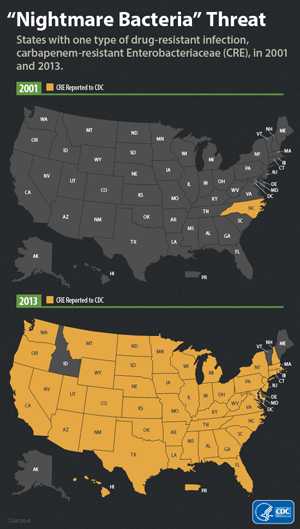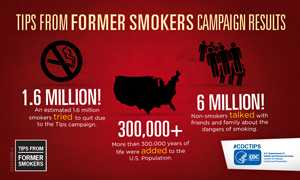This page is a historical archive and is no longer maintained.
For current information, please visit http://www.cdc.gov/media/
Media Advisory
For Immediate Release: Tuesday, December 31, 2013
Contact:
Media Relations
(404) 639-3286
CDC’s Graphs of the Year: Nightmare bacteria spread and 100,000 smokers likely quit with Tips

Infographic - Nightmare Bacteria ThreatStates with one type of drug-resistant infection, carbapenem-resistant Enterobacteriaceae (CRE), in 2001 and 2013.
Entire Infographic
CDC marks the end of 2013 with its eye on the threat of a “nightmare bacteria.” Every year, 23,000 people die as a result of infections that are resistant to antibiotics and more than two million people are sickened. Highly drug-resistant bacteria, known as carbapenem-resistant Enterobacteriaceae, spread from one medical facility in one state in 2001 to medical facilities in 46 states and counting in 2013.
CRE is resistant to most, and in some cases, all antibiotics. These microbes are especially deadly, and they can pass their resistance to other microbes through “jumping genes” or plasmids.
“CRE are nightmare bacteria. Our strongest antibiotics don’t work and patients are left with potentially untreatable infections,” said CDC Director Tom Frieden, M.D., M.P.H. “Doctors, hospital leaders, and public health, must work together now to implement CDC’s “detect and protect” strategy and stop these infections from spreading.”
CDC recently published its first report of the current antibiotic resistance threat to the United States. Healthcare facilities should follow CDC recommendations to halt CRE within their facilities.
100,000 smokers likely quit with Tips
The Centers for Disease Control and Prevention's 2012 Tips From Former Smokers campaign helped more than 100,000 Americans likely quit smoking for good, exceeding the original goal of 50,000. The 2013 Tips campaign generated 150,000 additional calls to quitlines and 2.8 million additional website visits.
This January will mark the 50th anniversary of the first Surgeon General's Report linking cigarette smoking to lung cancer. Smoking remains the leading cause of preventable death and disease in the United States, killing more than 1,200 Americans every day. More than 8 million Americans live with a smoking-related disease. Each day, over 1,000 youth under 18 become daily smokers. Smoking-related diseases cost Americans $96 billion a year in direct health care expenses, a substantial portion of which come in taxpayer-supported payments.

Infographic - Tips From Former Smokers campaign results
Entire Infographic
“Smoking and secondhand smoke kill – and they also harm smokers and non-smokers. The Tips from Former Smokers campaign shows the painful effects of smoking through former smokers, in a way that numbers alone cannot,” said CDC Director Tom Frieden, MD, MPH. “These are the kinds of ads that smokers tell us help motivate them to quit, saving lives and money.”
For more information on CDC’s work in 2013, visit:
Our Nation’s Health by the Numbers: 2013
CDC looks back at 2013 health challenges, ahead to 2014 health worries
Get email updates
To receive email updates about this site, enter your email address:
Contact Us:
- Centers for Disease Control and Prevention
1600 Clifton Rd
Atlanta, GA 30333 - 800-CDC-INFO
(800-232-4636)
TTY: (888) 232-6348 - Contact CDC-INFO
 ShareCompartir
ShareCompartir



